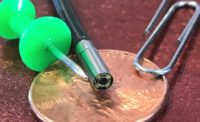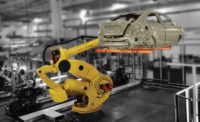Of all the various NDT disciplines, it is safe to say that remote visual inspection (RVI) is the one most widely used across all industries. While radiography and ultrasonic testing, for example, are essential in certain situations and applications, there is no real substitute for being able to visually inspect and monitor the condition of internal components. Furthermore, ongoing technological advancements in video borescopes serve to continually expand the range of uses and applications for RVI.
A Brief History
Borescopes have been used to visually inspect internal componentry for over 100 years. During most of that time, the instrument consisted of a narrow, rigid tube with integrated lens, mirror(s), eyepiece and light source. Over the past few decades, however, breakthroughs in materials, electronics and manufacturing techniques have led to a series of innovations that have greatly expanded the capabilities of borescopes and, in turn, broadened their use in industry.
The first major breakthrough in borescope design was the development of fiber optic bundles, which allowed borescope insertion tubes to become flexible. This flexibility permitted visual access through curved channels and pathways. Soon afterwards, manufacturers began attaching video cameras to the proximal end of the “fiberscope,” allowing the user an easier way to view the remote image and enabling the capture of photos and video. Eventually, image sensors, LEDs and lens designs became small enough that they could be mounted directly onto the distal end of a flexible insertion tube, and the modern “video borescope” was born.
Manufacturers have been building off of this “distally-mounted camera/LED module” design for the past 15 to 20 years, relying on advancements in PCBs and image processors, as well as ever-smaller and more powerful image sensors. The end result is that the rigid tube borescope of 100 years ago has evolved into a device that would be unrecognizable to early borescope users.
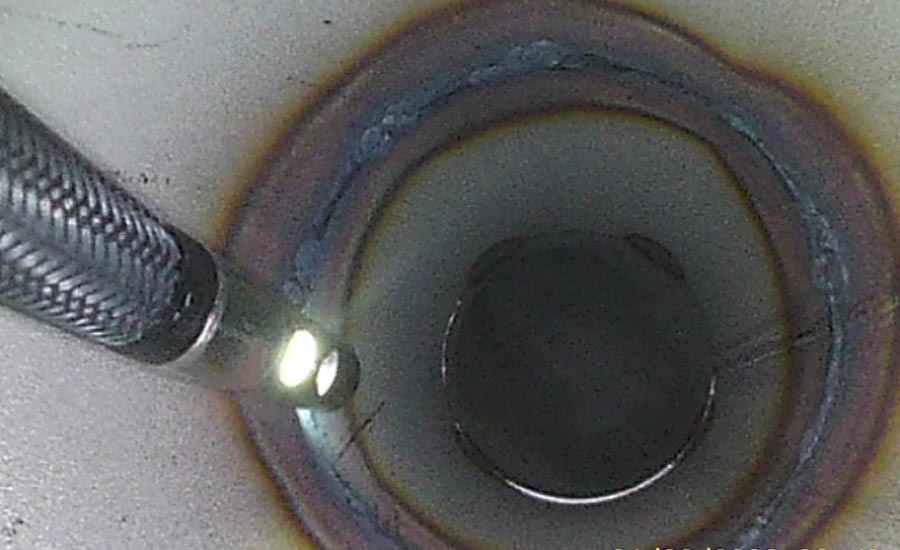
A side view camera is ideal when examining the condition of small diameter heat exchangers, and capturing photos of problem areas over time can help technicians predict when refurbishment or replacement will be necessary.
Technology that Drives Innovation
In the broadest sense, the technology that has most enabled the fundamental improvements in borescopes over the past 20 years involves:
- Smaller image sensors.
- Smaller and brighter LEDs.
- Smaller and more powerful image processors.
The common denominator is miniaturization, which lies at the heart of modern video borescope innovation. Smaller image sensors and LEDs allow for smaller diameter insertion tubes, which in turn permit access through smaller ports and narrower passageways. The state-of-the-art has evolved to the point that QC and repair technicians can now add to their arsenal a video borescope with joystick-controlled, four-way steering with an insertion tube diameter as small as 2.8mm. Needless to say, the potential applications for this type of technology increase exponentially when diameters get this small.
User Feedback that Drives Innovation
While miniaturization of key components lies behind much of the progress we see in borescope technology, requests for new features from current and prospective borescope users have also compelled the development of new products and creative solutions. This feedback loop between borescope manufacturers and technicians in the field becomes even more important as technological advancements greatly open up the possibilities of what can be designed and produced. As anyone who has been in business knows, just because something can be built does not mean there is a market for it, and it is the end-user—not the sales and marketing department—who will ultimately decide whether a certain feature is worthwhile.
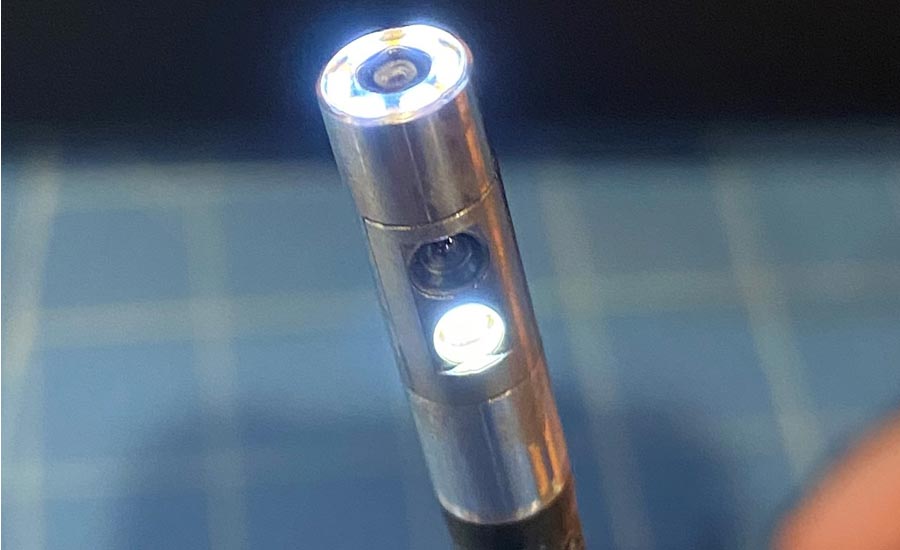
This dual-camera module speeds up and simplifies the inspection procedure by providing a forward view that is ideal when guiding and steering the insertion tube into the inspection area, at which point, with the press of a button, the user can switch to the side view camera in order to inspect the target.
Dual Camera Modules
One recent breakthrough in borescope technology that is the direct result of the convergence of technology and customer feedback is the dual camera module. While the majority of borescope applications require only a forward view camera, there are certain inspections that call for a side view camera, typically because of extremely tight confines that don’t leave enough room for movement of the articulating tip. In the past, these side viewing requirements have been met by attaching a mirror, prism, or other type of adapter to the distal end of the insertion tube. While these side view adapter configurations can provide excellent image quality in tight spaces, they do limit the technician to an either/or choice: either forward view or side view, but not both. Now, thanks again to miniaturization, four-way articulating modules with two cameras—one forward view and one side view—are available. This dual-camera module speeds up and simplifies the inspection procedure by providing a forward view that is ideal when guiding and steering the insertion tube into the inspection area, at which point, with the press of a button, the user can switch to the side view camera in order to inspect the target.
Applications for Dual Camera Borescopes
While fully-articulating dual camera borescopes are still fairly new to the market, some early indicators of key applications are already beginning to appear. These applications include:
Orbital welds in process piping. If process piping is over 3” in diameter, usually a forward view borescope with at least 90 degrees of articulation will be able to deliver a good view of the interior orbital weld. When pipe diameter gets below 3”, it becomes more difficult to obtain a straight-ahead view of the welds when using a forward view camera, even if the camera has a wide field of view. For small ID pipes, the side view camera solves this problem and can provide an excellent, straight-on view of welds in pipes as small as ¾” ID.
Heat exchangers. Pitting, scale buildup and corrosion in heat exchangers reduces efficiency and can lead to system failure if left untreated. A side view camera is ideal when examining the condition of small diameter heat exchangers, and capturing photos of problem areas over time can help technicians predict when refurbishment or replacement will be necessary.
Cast metal parts. Dual camera modules can be very useful when inspecting the inside of cast metal parts for burrs, pin holes or slag inclusion. Once inside the component, if there is enough room to point the forward view camera at the inspection target, then this camera should be used. If a certain channel is too narrow, however, this is when the side view camera can be activated to get a closer look at surface areas perpendicular to the camera module.
Bearings and inner/outer races. Gear assemblies and gear boxes seem to be getting more complex and crowded all the time. This has been great for drive efficiency and system performance, but it makes inspecting the gears correspondingly more difficult. The dual camera module has proven useful in providing visual access to gear and bearing components that are tightly spaced and otherwise inaccessible.
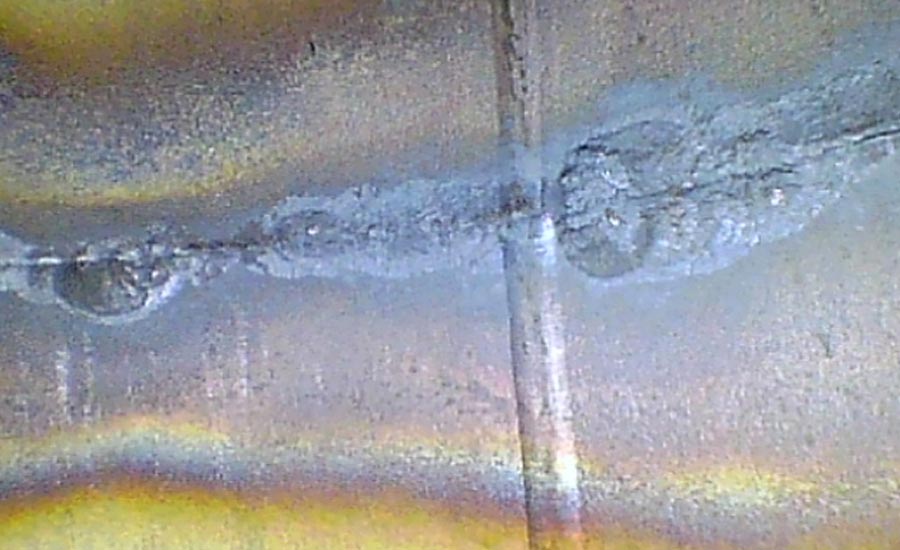
For small ID pipes, the side view camera solves this problem and can provide an excellent, straight-on view of welds in pipes as small as ¾” ID.
Disadvantages of Dual Camera Borescopes
While a dual camera module can increase the utility of a borescope for some users, there are certain drawbacks that need to be considered. First, a dual camera module is about 6mm longer than a single camera module, which increases the bending radius of the distal tip, something that can be especially relevant when snaking the insertion tube through multiple tight turns. Additionally, because extra power is required to run two sets of cameras and LEDs, a slight reduction in maximum light output is necessary in order to keep overall module heat levels within a safe tolerance. Finally, a dual camera borescope will cost somewhere between 5% and 10% more than a similar scope with only one camera.
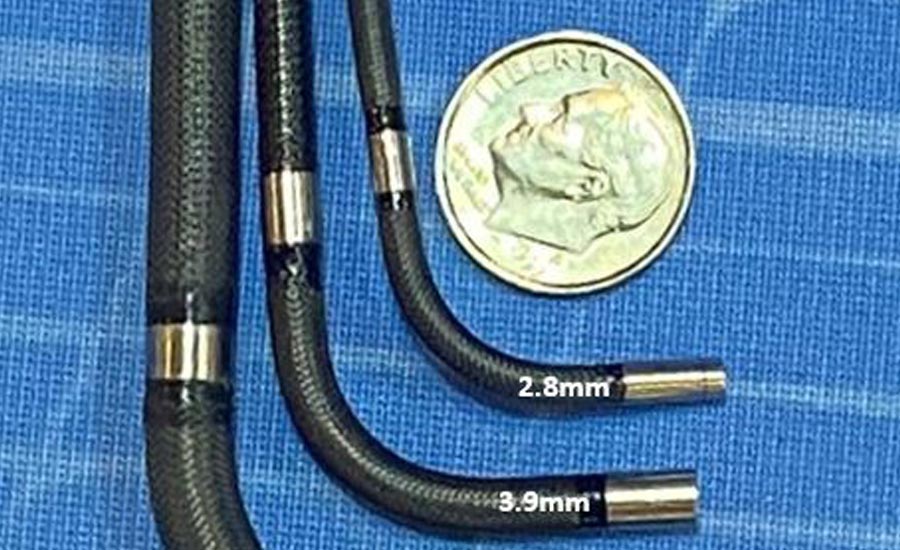
The potential applications for this type of technology increase exponentially when diameters get this small.
Do Your Homework
As with any purchase of high-tech NDT equipment, it is important to know that your investment is going pay off. Everyone’s situation is unique, and just because a piece of gear may get rave reviews from your colleague on the other side of the country doesn’t mean that you’re going to feel the same way about it. A good place to start is by accurately defining the problem you are trying to solve. What inspection, maintenance or repair process are you trying to improve or speed up? Then have a discussion with a knowledgeable sales consultant about your application, what you want to achieve, and whether the equipment under consideration is suitable to the task. Finally, you should evaluate the equipment in your facility and on your actual inspections before buying it— this is the absolute best way to be sure that you’re going to happy with your investment over the long haul.

